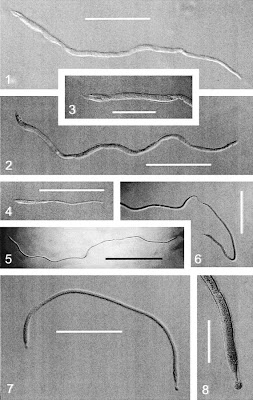Johan got the last one -- it was Colacium, a euglenid of all things! Ok, for this one, you might not get to the genus, but the more you narrow it down, the better. Sorry, 'eukaryote' doesn't count. Warning: It's evil.
Change of address
4 months ago in Variety of Life



















Might it be Kentrophoros?
ReplyDeleteIt's a gregarine, right? Gregarina?
ReplyDeleteGood guesses but no and no.
ReplyDeleteEvil? Is it a Plasmodium?
ReplyDeleteNah, I don't really consider parasites to be 'evil' -- they're just trying to get by like the rest of us...
ReplyDeleteAh, I thought you might be making a play on words. The "Mal" in malaria means evil.
ReplyDeleteOooh, thanks Paul, I didn't even realise that... so Malaria is something like 'evil air'? Vaguely recall having heard something about that before somewhere...very vaguely.
ReplyDeleteDo you guys need help there?
Hint?
ReplyDeleteIs it a Trachelocerid?
ReplyDeleteNope. Good job on the obscurity factor though!
ReplyDeleteCompletely off-topic, but I heard that karyorelictids tend to be really understudied for the reason that...most ciliatologists just happened to live inland! Funny how geography can influence research...
Another hint: the answer may surprise you. One doesn't typically think of these organisms to look like that...
ReplyDeleteIs it a prostoma?
ReplyDeleteNope.
ReplyDeleteThink 'shells'.
How about Nemogullmia?
ReplyDeletePaul: you win! It wasn't Nemogullmia, but, in the authors' words: "Thread-like and other elongate organic-walled allogromiids"; undescribed species. I was basically just looking for "allogromiid'. The bottom one is Tinogullmia sp., another allogromiid. I find it really cool how un-foram-like they are!
ReplyDeleteTotally meant to reveal the answer earlier, but was travelling and didn't get around to posting the answer...
That is really cool! I had no idea that there were forams like that out there.
ReplyDelete